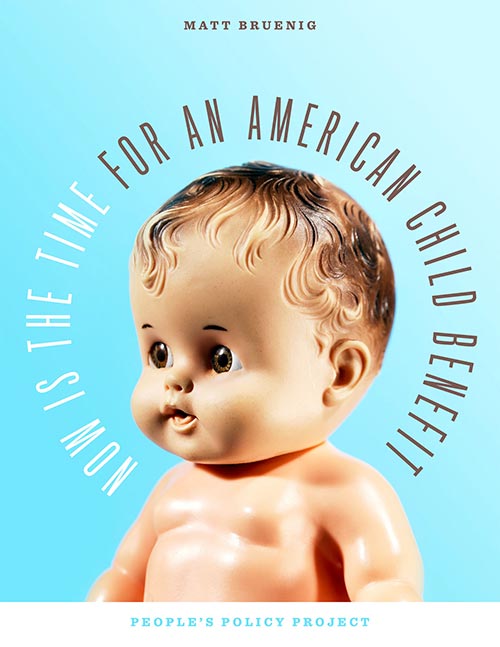In this paper, I argue that the US government should eliminate the Earned Income Tax Credit (EITC), the Child Tax Credit (CTC), and Additional Child Tax Credit (ACTC) and replace them with a monthly $374 check paid out to every child in the country. This move would radically simplify the US child benefit system, nearly wipe out child poverty in the country, and provide income-smoothing to all families whenever they have children.
Tax Credit Mess (On Paper)
The US child benefit regime currently consists of three duplicative and bizarre tax credit programs that all do the exact same thing: provide a benefit that phases in based on a family’s income and then phases out based on a family’s income. This phase-in/phase-out pattern is sometimes called a trapezoid benefit because that is the shape it makes when depicted on a graph.
In the six graphs below, we can see how much money families are supposed to receive from each of these programs, based on their tax-filing status, earnings level, and number of children.
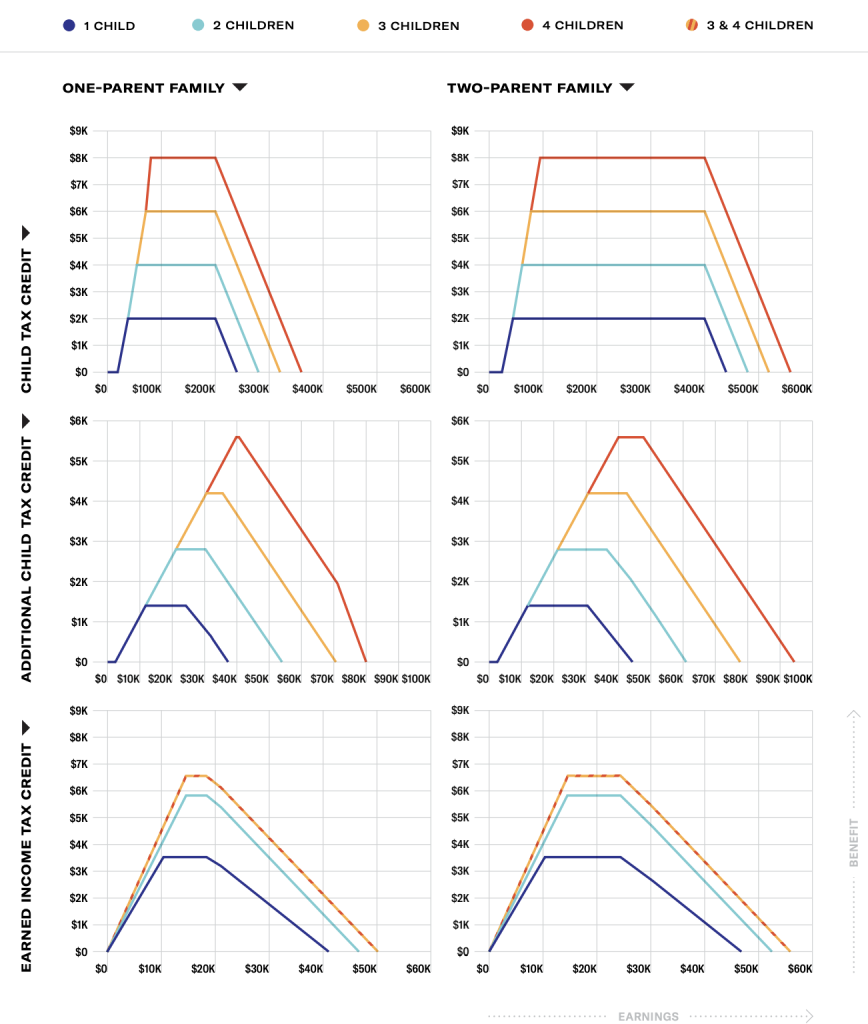
In the next two graphs, I add all these credits together and then divide by the number of children to produce a depiction of what the scheme looks like overall.
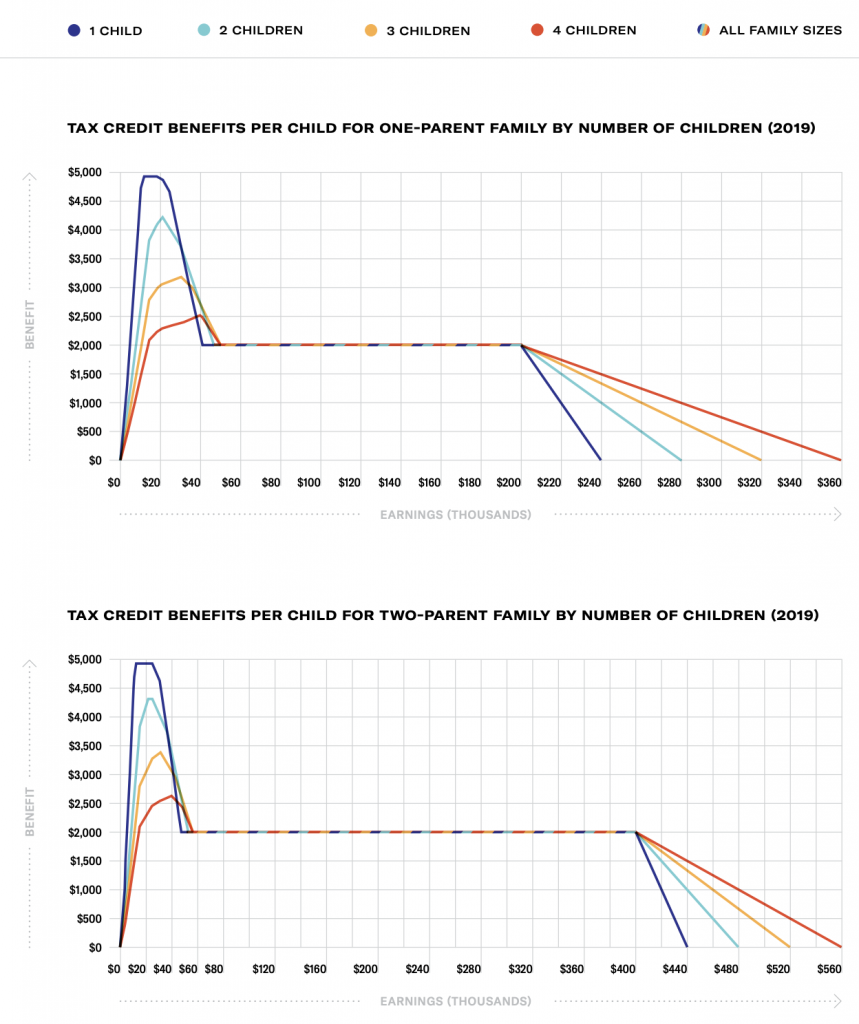
The graphs I have presented so far illustrate how much money a family at a particular earnings level should receive from these programs. But it does not illustrate how many kids actually live in families at each earnings level. This means that these graphs do not provide much insight into the overall distribution of these benefits across low-income, middle-income, and high-income families.
To see how these benefits are distributed overall, we can look at the next graph, which was produced using the Annual Social and Economic Supplement of the Current Population Survey. This graph shows how much money kids receive from these various programs, on average, at every percentile of the earnings distribution.
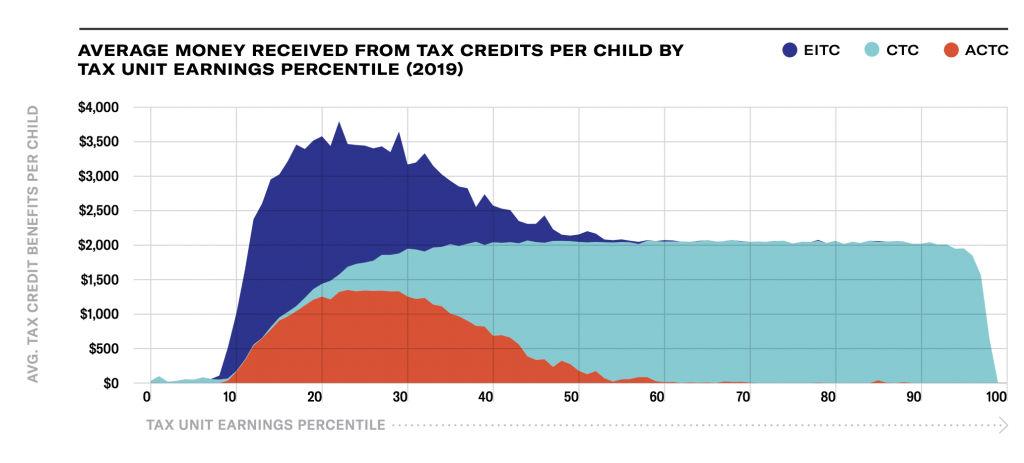
This analysis shows that the poorest 9 percent of children receive essentially nothing from these tax credit programs while the next poorest 11 percent of children receive less than the maximum amount. Overall then, the country’s child benefit regime partially or entirely excludes the poorest fifth of American children.
Remarkably, even though these tax credits phase out on those with very high incomes, the vast majority of rich people are still eligible for significant benefits. As a result of this, children at the 95th percentile of the earnings distribution receive 40 times as much money from these programs as children at the 5th percentile do.
We can reproduce this same graph for each racial group as well, which is what I do in the next three graphs.
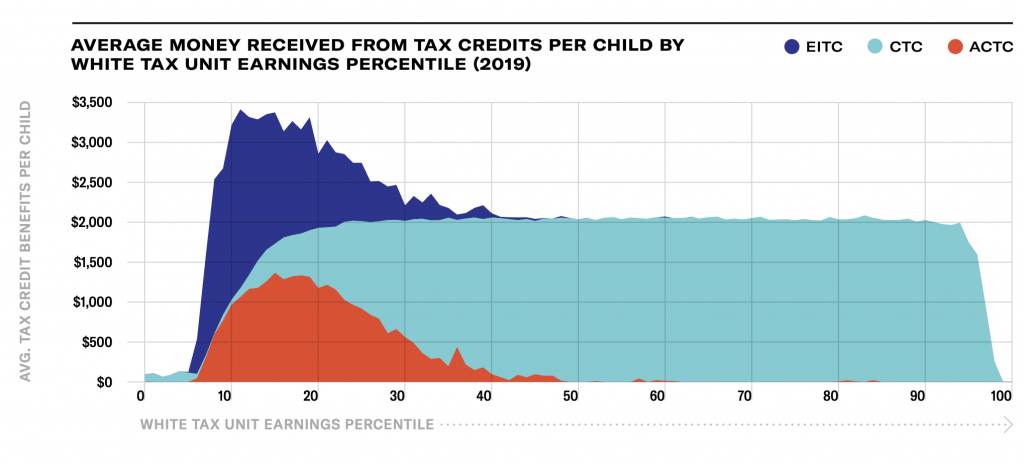
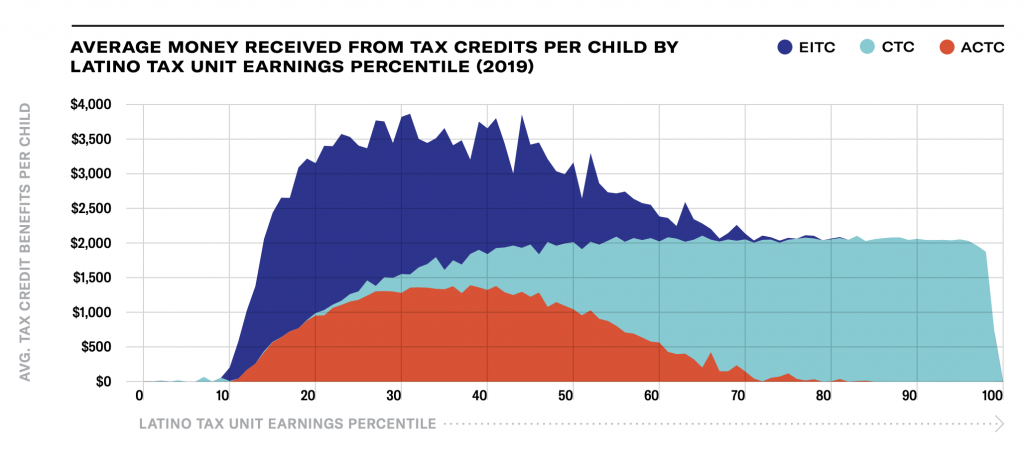
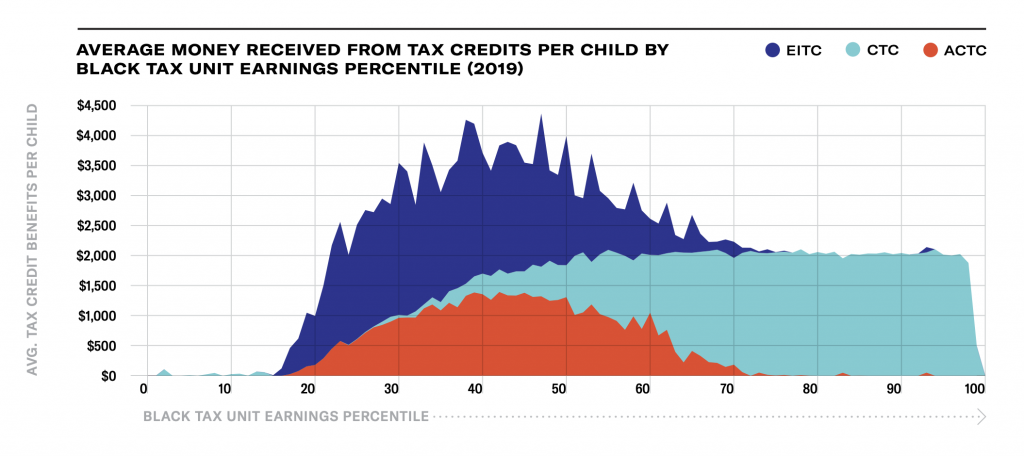
The poorest 7 percent of children in white tax units are almost entirely excluded from these benefits. For Latino children, it is the poorest 10 percent. For black children, it is the poorest 16 percent. Thus, as with any program designed to exclude the poor, the current tax credit regime disproportionately leaves out nonwhite people.
Tax Credit Mess (In Reality)
As bad as these tax credits look on paper, the real-life versions of them are even worse. The statistics I have presented so far assume that all eligible children receive the benefits that they are entitled to. But we know from IRS and Census data that this is not true.
According to the IRS, only 78 percent of eligible tax units receive the EITC benefits that they are entitled to. And, according to the Census, nonparticipation in the EITC is skewed towards lower-income families with children. Indeed, if you look at who actually gets the EITC based on IRS administrative data, rather than simply assuming everyone who is eligible gets it, you discover that conventional estimates of how much money the EITC provides to poor families are vastly overstated. For example, in 2014, the tax models tell us that the EITC lifted 4.8 million people over the federal poverty line while the actual IRS data tells us the real number was just 3.2 million people. This means that most estimates of the EITC’s impact—including the estimates used in the graphs above and the figures published frequently by the Census and other think tanks—overstate the EITC’s antipoverty impact by 50 percent.
As far as I know, nobody has conducted similar research into the real-life versions of the CTC and ACTC, but it is hard to imagine why they would be any different than the EITC, seeing as the three programs are identical in all relevant respects. The low-income families who are failing to claim the EITC are also almost certainly failing to claim the CTC and the ACTC.
Tax Credit Deception
The policy community has consistently misled policymakers and the media about the effectiveness of tax credits. They do this in two ways:
- They present estimates about the antipoverty effects of tax credits that assume everyone who is eligible get the benefits even though that is demonstrably false. As noted already, the Census has cautioned that this kind of assumptive modeling is overstating the effect of these programs by 50 percent.
- They use the headcount poverty measure to determine how effective a program is at reducing poverty. The problem with the headcount poverty measure is that it does not distinguish between someone whose income is $1 below the poverty line and someone whose income is $10,000 below the poverty line. A program that provided $1 to the former person would count as reducing poverty while a program that provided $9,999 to the latter person would not. As we see in the graphs above, tax credits exploit this weakness by intentionally skipping the poorest 9 percent of kids and then sprinkling a relatively modest amount of money on those with incomes just below the poverty line. This does not provide much in the way of genuine poverty relief, but it allows dishonest operators to claim it does.
Once you account for how many poor people are excluded from tax credits — either by the rules of the program or by the difficulty of applying for the program — it is very clear that these are not very good programs.
The $374 Alternative
To replace this mess, I argue that we should have the Social Security Administration simply send out $374 every month to every child in the country. The $374 figure is chosen because, under the federal poverty guidelines, this is the amount it would take to ensure that no family ever slips into poverty solely because they added a child to their family.
The lack of a benefit phase-in will ensure that all poor families (and rich families) are eligible for the program. The lack of a benefit phase-out will ensure that poor people do not wind up excluded from the program by the paperwork burden that means-testing always comes with and ensure that all families benefit from income-smoothing when they have a child. These features of the program would make the program vastly more effective at reducing poverty and guarantee that all families with minor children benefit in a tangible way that they can see in their bank account every 30 days.
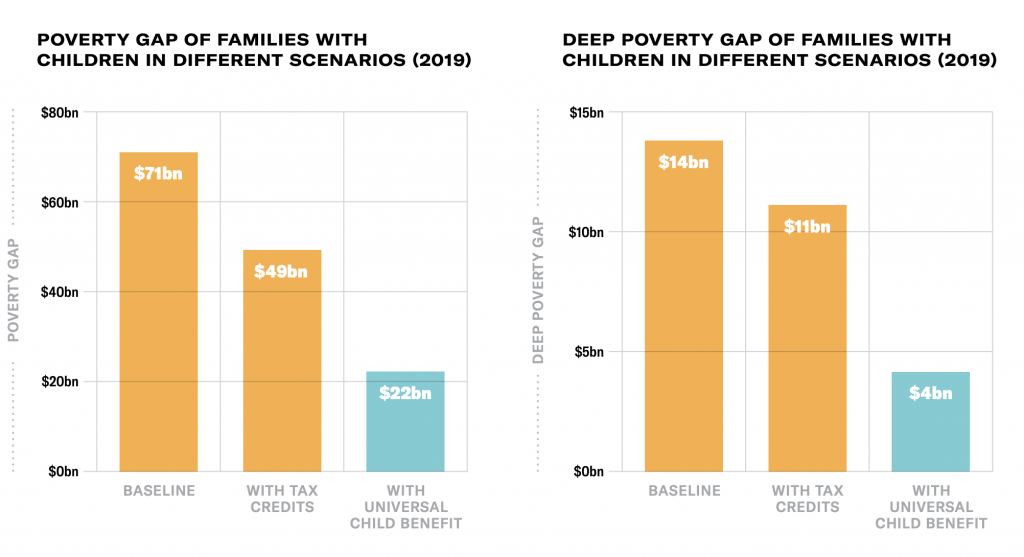
Conclusion
When the government provided two series of checks to nearly every family in the country last year, the typical family of four received $5,800 in direct cash assistance from the government. These checks were wildly popular, so much so that even the great majority of Republican voters tell pollsters that they want to see more of them.
Democrats should learn the lesson of this success: clear and simple programs that provide salient benefits to everyone are both effective and politically beneficial.
What to do about our child benefit regime is likely to be a topic of much interest to politicians over the next two years. Democrats have already shown an interest in reforming the system, but so far have ignored the wisdom revealed by the stimulus checks and gravitated towards doubling down on these failed tax credit programs.
If something is worth doing, it is worth doing right, and the objectively superior way to organize child benefits is through a universal check paid out monthly to every family.

